These Baked Butternut Squash halves bake up so sweet and tender. With just a little butter, salt and pepper they are an effortless way to create a delicious side or flavorful filling. Learning how to bake Butternut Squash has never been so easy!
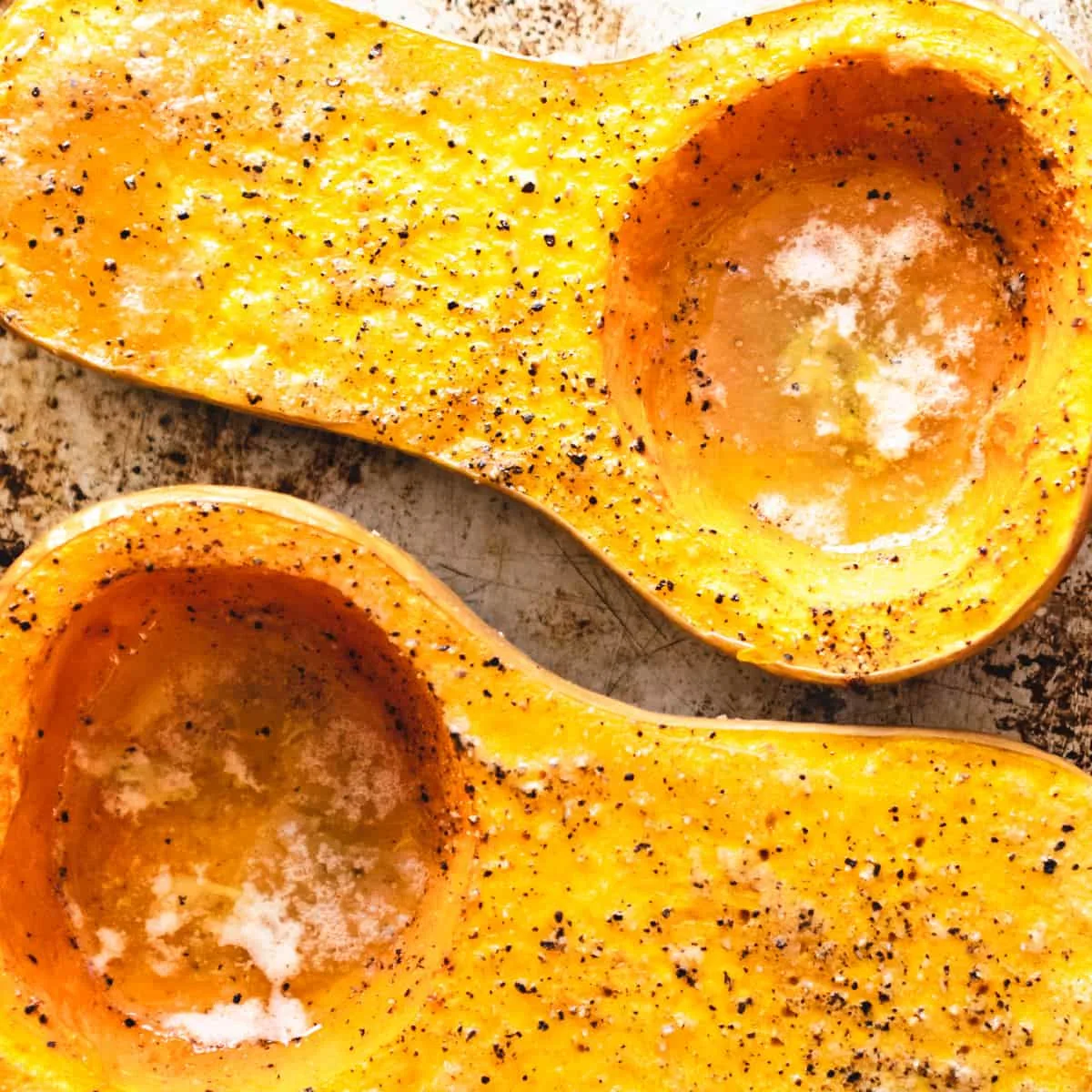
Baking butternut squash is a really easy way to enjoy the squash alone, as a side dish, or to prepare it for use in other recipes.
What's the best way to cook a butternut squash?
The best way to cook butternut squash in the oven is also the most delicious and happens to be extremely easy.
Using this roasted butternut squash recipe makes for a simple side dish to add to any dinner recipe.
Why you should learn how to bake butternut squash
- This recipe is very, very simple to follow.
- You don't need anything crazy, just some pantry staple ingredients and kitchen tools you already have in your cabinets.
- A butternut squash is versatile. It's easy to prep an entire squash now and have it for various, multiple meals later on throughout the week.
- Using butternut squash is simple and can be used in many different kinds of recipes. It can be used as a side, as an ingredient in something like a salad, it can be used in a sauce, in butternut squash soup, and so much more.
Ingredients and Tools
The only ingredients you need are a butternut squash, butter, salt and pepper.
The only tools you'll need are a sharp knife, baking sheet, and something to scoop out the seeds with such as a spoon.
You can throw down a piece of parchment paper or aluminum foil for easy cleanup if you like.
How to choose a butternut squash
Here are a few different things to keep in mind when you're at the grocery store or farmer's market getting ready to pick out the perfect butternut squash.
An average sized squash can be anywhere between 1 ½ to 2 pounds in weight.
Look at the skin on the butternut squash.
If there is any green whatsoever, it's not ripe.
The skin should be hard, one solid color, and matte--not glossy anywhere.
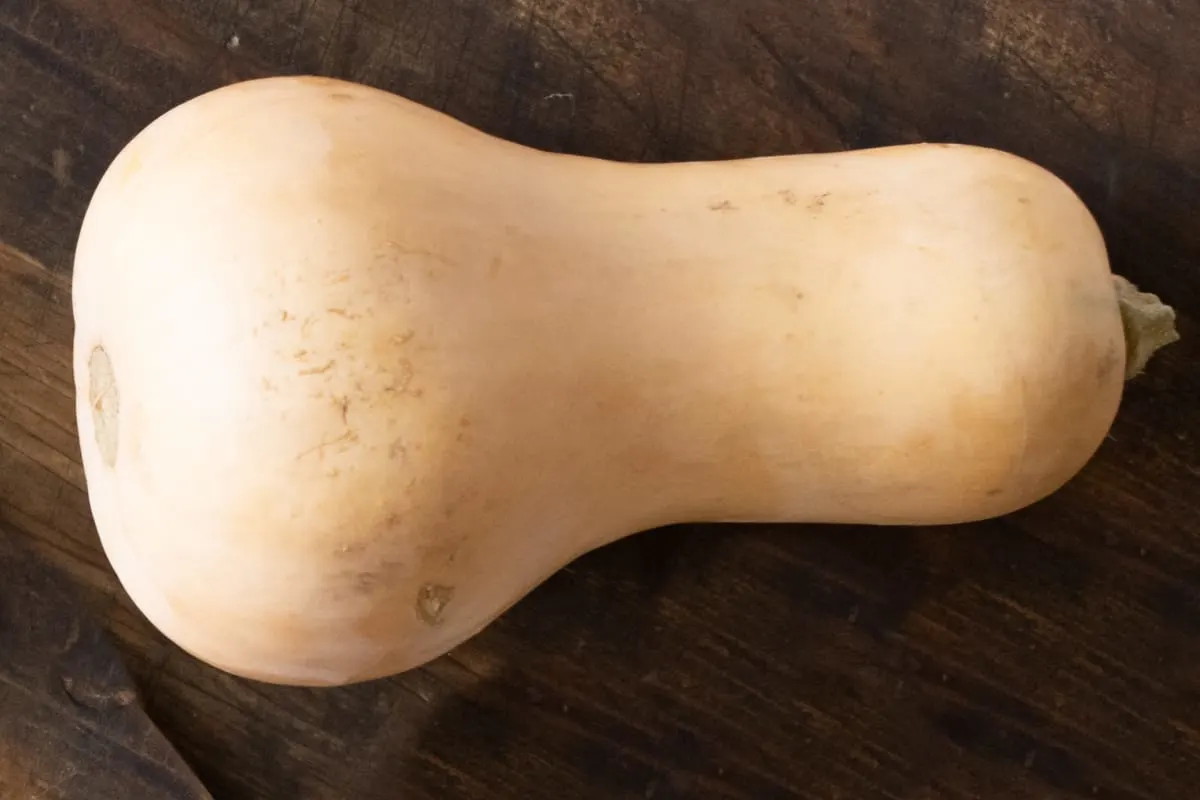
You might find a few dings or dents in the skin of the squash and that's totally normal.
How to Cook Butternut Squash
Here are the few, general basic steps to learn how to bake butternut squash easily. Start by prepping your squash, baking and then enjoying!
Preparation
Preheat the oven to 400 degrees Fahrenheit. Position the rack in the middle section.
Use a very sharp chef's knife with about an 8 inch blade to handle the large fruit.
Butternut squash has a hard rind, and if your knife is dull, it can be difficult to slice through. You can slip and injure yourself if you're not careful.
Cut from the top where the step was down vertically through to the bottom.
Scoop the seeds out with a spoon, as you would when carving a pumpkin.
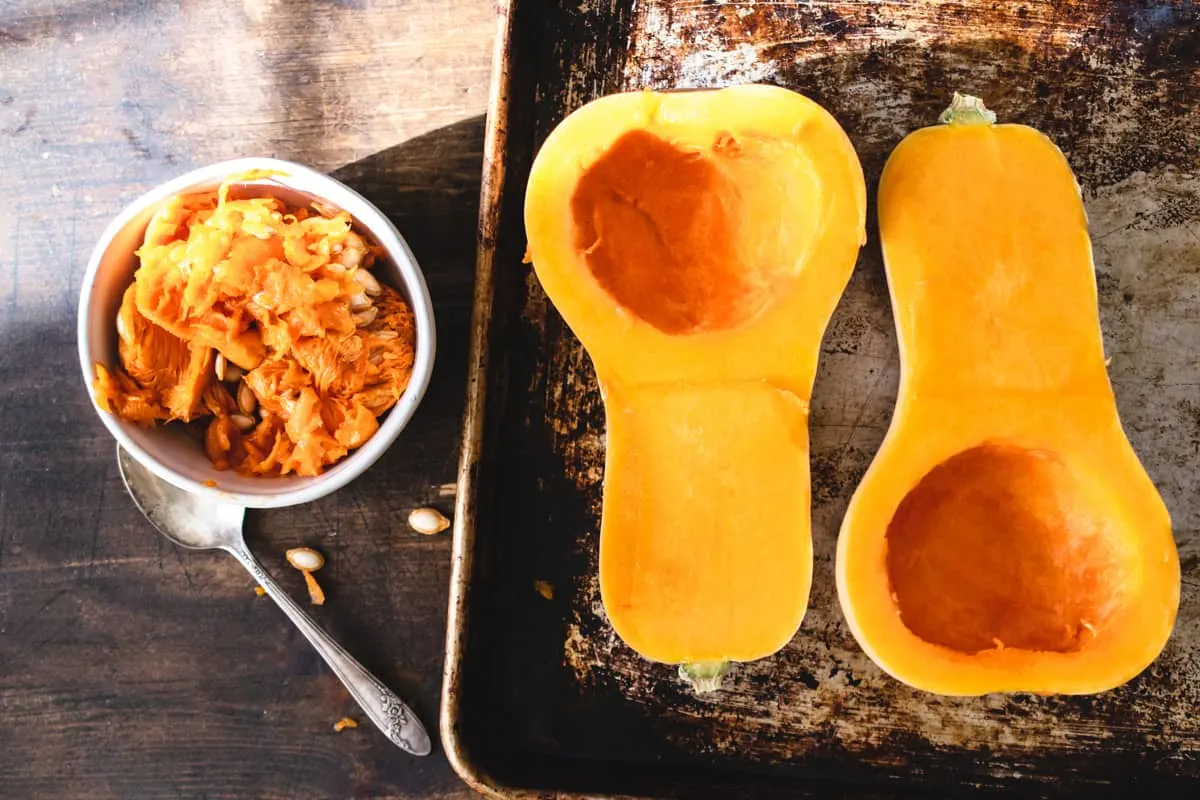
You can use olive oil, however butternut squash is infinitely more delicious when roasted with butter.
The butter caramelizes and browns deliciously, and it wells up in the cavities of the squash turning toasty and delicious for drizzling over the squash later.
Poke the squash halves all over the tops that face upwards using a fork. This not only helps steam to escape, but it lets some of the butter melt and drip down inside.
For easy cleanup after baking the butternut squash, line the baking sheet with parchment paper or foil.
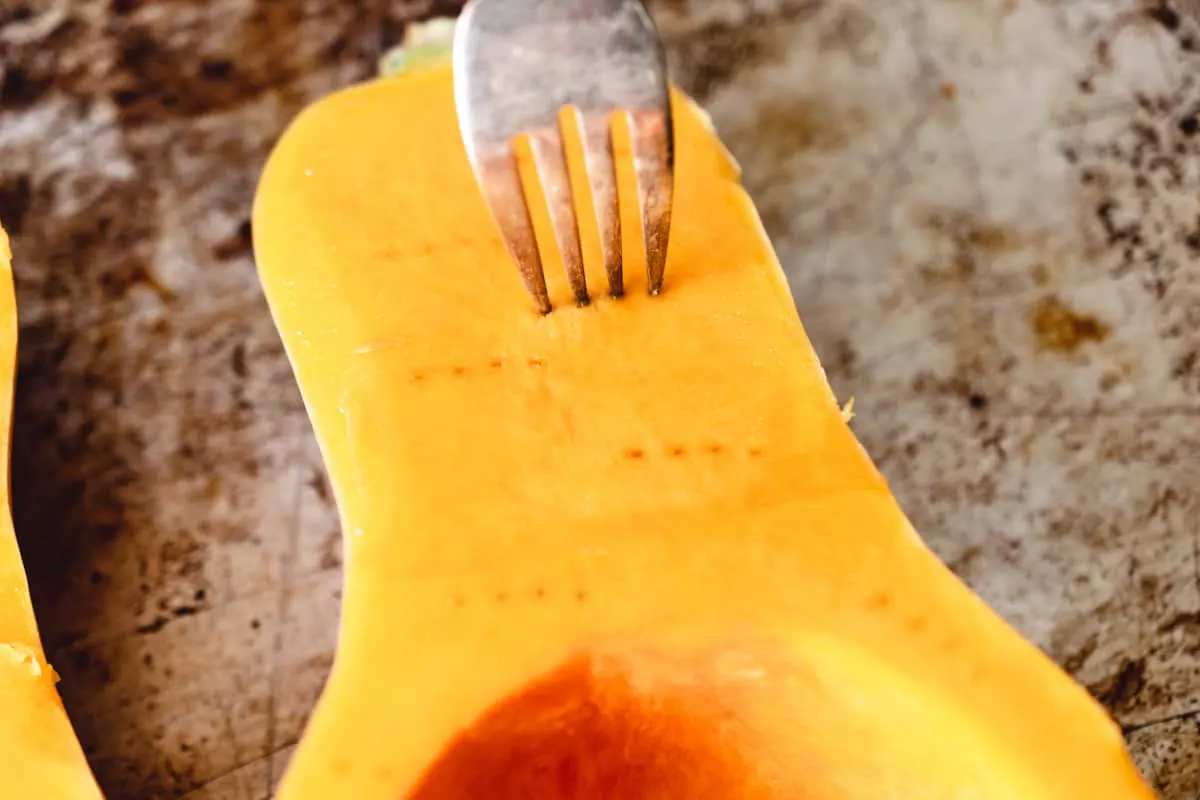
Spread about 1 tablespoon of softened butter over the tops of the butternut squash halves after they've been pierced with a fork.
Place one additional pad of butter inside each cavity, and salt and pepper liberally.
Coarse ground pepper and kosher salt work really well on baked butternut squash, because they add texture that compliments the little caramelized edges that will form during the baking process.
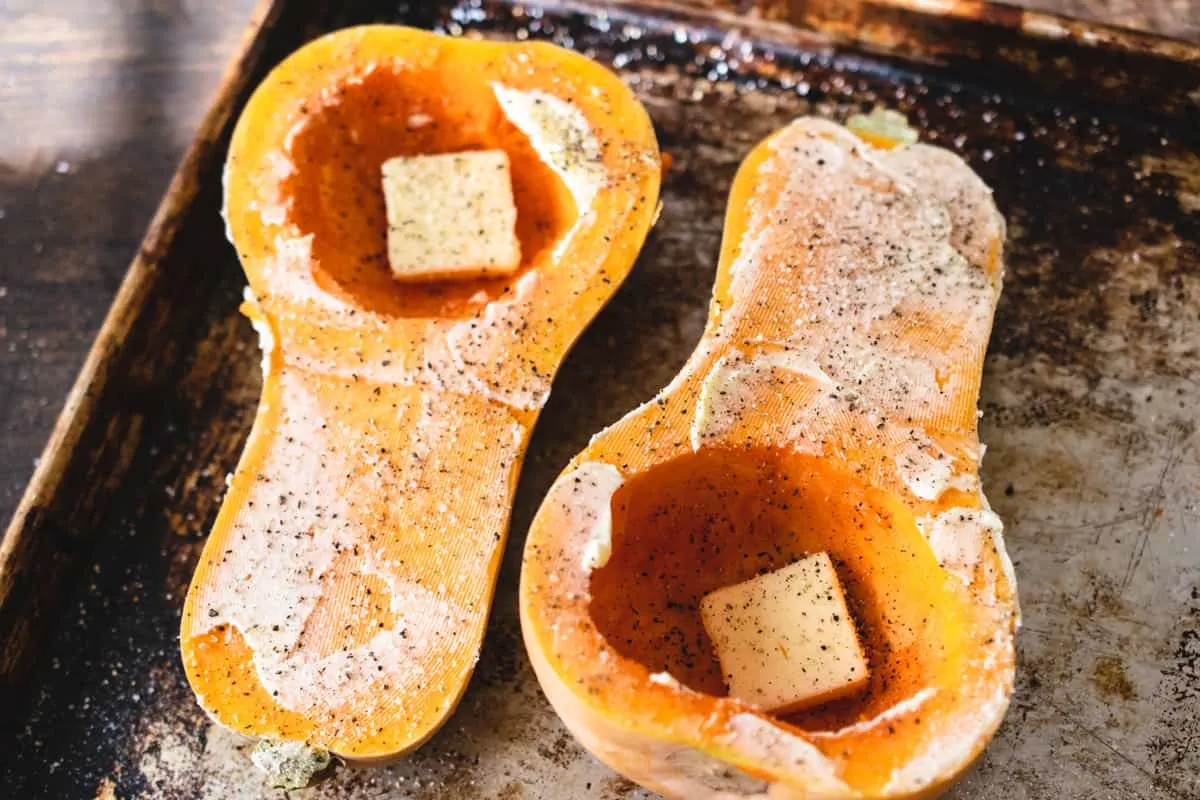
Bake
Bake the squash halves at 400 degrees Fahrenheit for about one hour, checking at 45 minutes just in case.
Some smaller squashes weighing less than 1 ½ pounds may take less time.
Larger squashes weighing over 2 pounds may take up to 90 minutes.
If you notice the halves getting too browned, just place a piece of foil loosely over the tops and remove during the last 10 minutes.
How do I know when my butternut squash is done cooking?
The butternut squash is done baking when it's fork tender, meaning that it's tender enough to easily stick a fork in without much resistance.
You'll also notice the beautiful browning and sweet caramelization that has happened on the edges and surface of the squash.
Eat
There is no incorrect way to enjoy this beautiful and delicious baked butternut squash halves.
You can eat it right out of the skin, or slice the squash short ways, in ½ inch slices and enjoy it with skin on.
Baking it makes the skin tender enough so that you can just leave it on and eat it.
You could also choose to let the baked squash halves cool, then scoop the squash out with a large spoon for use in soups, sauces, or pasta fillings.
You can even make these types of preparations ahead of time and freeze the pureed squash for use in the perfect recipe later.
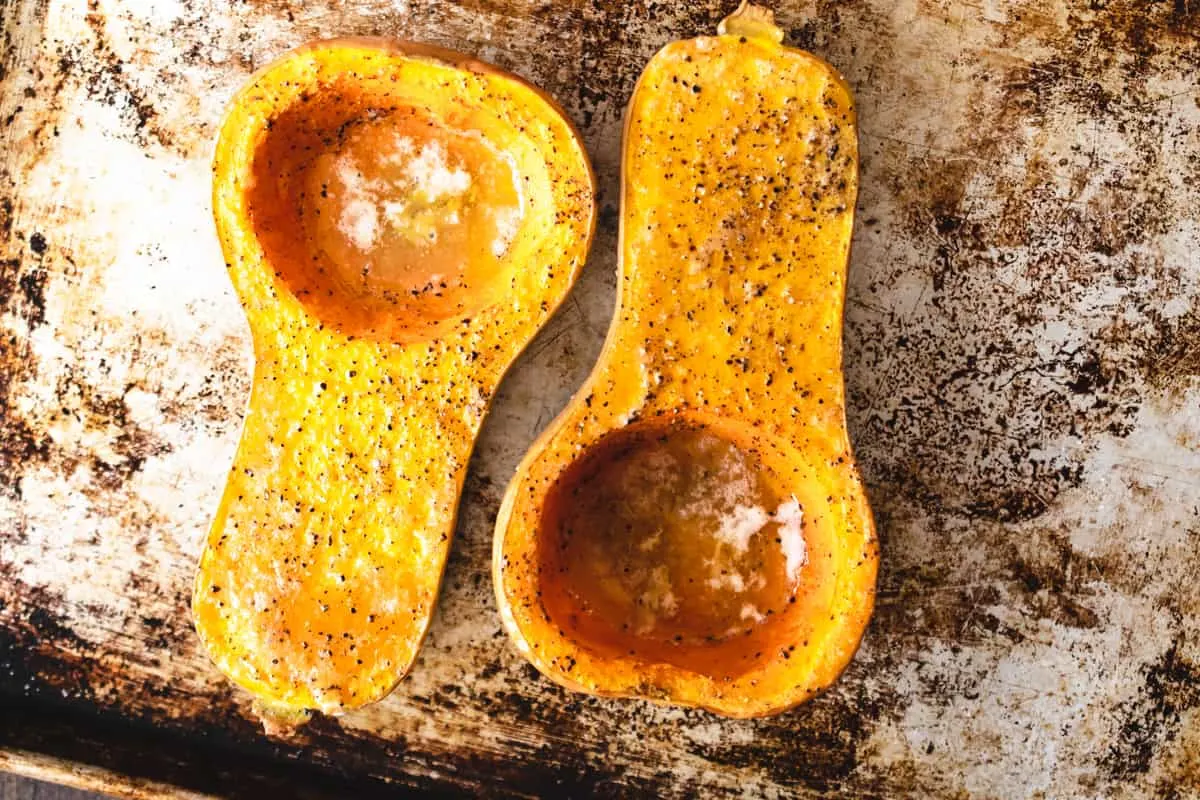
Can you eat the skin of a butternut squash?
Technically, yes, you can eat the skin. But, I have found that the texture is not all that appetizing, even if you roast it a little longer attempting to make it more tender.
I have also found that most squash is covered with a wax protectant layer that is applied to help the squash last longer. While this is technically edible, it's not something I want to enjoy so that definitely has to be scrubbed off- and that's not always easy to determine if it's all gone or not.
So, I prefer to either peel it off if I'm dicing the squash up, or just scoop the flesh of the squash out of the skin and enjoy it that way.
Storage
Store any leftover butternut squash in an airtight container and keep in the fridge for up to 4-5 days.
Keep your leftover longer by placing in a freezer safe container or freezer safe bag and freezing for up to 6 months. Additionally, you can puree your squash or make a soup to freeze for up to 6 months.
If choosing to puree the squash, we like to freeze in smaller chunks or blocks so you can use smaller portions in different recipes. Once you've pureed to your desired thickness, pour it into an ice cube tray and freeze.
After you've frozen the squash puree, pop the cubes out and toss them in a freezer-safe container or bag. Label the container and store for up to 6 months.
Can you freeze raw butternut squash?
Sure! If I have extra raw butternut squash that I can't use before it goes bad, I like to freeze it raw and uncooked for later use. If you don't want to decide how to cook it now, leave that decision for later.
You can cut it in half and then dice it in small pieces and flash freeze the cut squash. Once the pieces are frozen, transfer them to a container or bag and freeze for up to 6 months.
Different Ways to Prep and Bake Squash
If you don't want to eat the squash straight from the skin, or cut it in slices, you can absolutely prepare it other ways.
I have seen other who peel the butternut squash first. Use a vegetable peeler and remove the skin of the squash. It's not as hard as you think and comes off rather quickly and easily.
Then you can slice the whole squash in half length ways as you would in my original method.
Next use a spoon to remove the seeds and then dice the squash halves into 1-inch cubes. I find this is easiest if I cut the halves into slices and then dice them up.
You can add some pads of butter with the salt and pepper over the diced pieces for some delicious flavor as you would in my original recipe, or choose to season and enjoy other ways.
All that's left is to bake it. Pop the squash cubes on a baking sheet lined with parchment paper in a single layer and bake in a preheated oven at 400F for 30-35 minutes.
Larger squash may need twice the time, smaller may need less. Keep an eye on your squash pieces in the oven so you don't roast them to a crisp. You want the flavorful squash to have a hint of golden brown on pieces, but not charred coloring.
Store your cooked pieces just as you would have in a container or in the freezer.
Other ways to season your winter squash
- Instead of using butter, try drizzling with oil. Avocado oil, melted coconut oil, or olive oil would all be delicious on top. Although, I stick to my butter as being the most flavorful way to enjoy your squash.
- Salt and pepper is a classic and simple way to flavor and roast butternut squash, but you can change up the flavors by sprinkling with garlic powder, onion powder, oregano, and other spices.
- Try adding some fresh grated parmesan cheese and tossing in some small diced bacon pieces for a real treat of flavor and texture.
- If you want a sweeter flavor, you can add some brown sugar and drizzle with maple syrup or local honey.
Helpful Tips
- If you're having a hard time getting the seeds out, instead of a spoon, try using an ice cream scoop. I find that can be the easiest way to scoop the guts out.
- When cutting your squash up, always place the flat sides down on the sturdy cutting board. It's easier to cut anything this way and will give you a stronger grip on the knife and steadiness in your arm while cutting. This is great kitchen safety skills.
- If you're short on time, instead of setting aside time to cut your whole butternut squash, you can buy squash pre-cut and then follow the "Different Ways to Prep and Bake Squash" section.
- Be sure to move the rack in the oven so you don't roast the squash too close to the heating element. That's a recipe for a quick disaster if you aren't planning on attempting to broil it.
- The necessary bake time for your squash can vary widely depending on the size of the squash. Don't just set it and forget it.
- You can use this easy step-by-step recipe with other winter squashes. Spaghetti squash, acorn squash and other winter squash varieties are all great when prepared using this cooking method. The cooking time may vary depending on the size of the squash, but it's generally very similar. Top with butter and some fresh herbs and enjoy!
Whichever way you choose to make this delicious side dish, be sure to keep an eye on the squash in the oven so you don't over cook it. This really is a simple recipe and is great to use in other recipes.
Related Recipes
Try these butternut squash recipes, and other similar dishes.
If you tried this recipe for oven baked butternut squash, leave a rating in the recipe card, or drop questions and comments below.
📖 Recipe
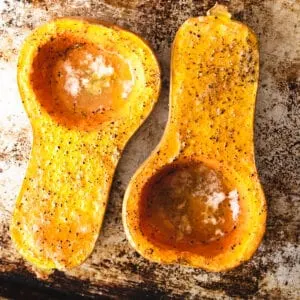
How to Bake Butternut Squash
Ingredients
- 1 butternut squash
- 4 tablespoons butter
- 1 teaspoon kosher salt
- ½ teaspoon coarse ground black pepper
Instructions
- Preheat oven to 400 degrees.
- Cut the butternut squash in half lengthwise from stem to the bottom.
- Scoop the seeds and pulp out of the cavity.
- Lay on a baking sheet and spread 1 tablespoon of softened butter on each half.
- Sprinkle the top of each half liberally with salt and pepper.
- Place a pad (1 tablespoon) of butter in each cavity.
- Roast for about 1 hour until fork tender.
Notes
- Choose a squash that doesn't have any green spots, has matte (not shiny) skin.
- A few dings and dents are normal.
- Butter roasts better on the squash and is recommended over olive oil for this recipe.
- Don't forget to stab the squash halves on their cut side up, with a fork several times before buttering.
- Coarse salt and coarse ground pepper adds good texture and is preferred for roasting/baking the butternut squash.
- Small squashes may only need to cook for 45 minutes, larger ones may need to go as long as an hour and twenty minutes.
- The squash can be tested for doneness by poking a fork in the flesh to see if it's "fork tender".
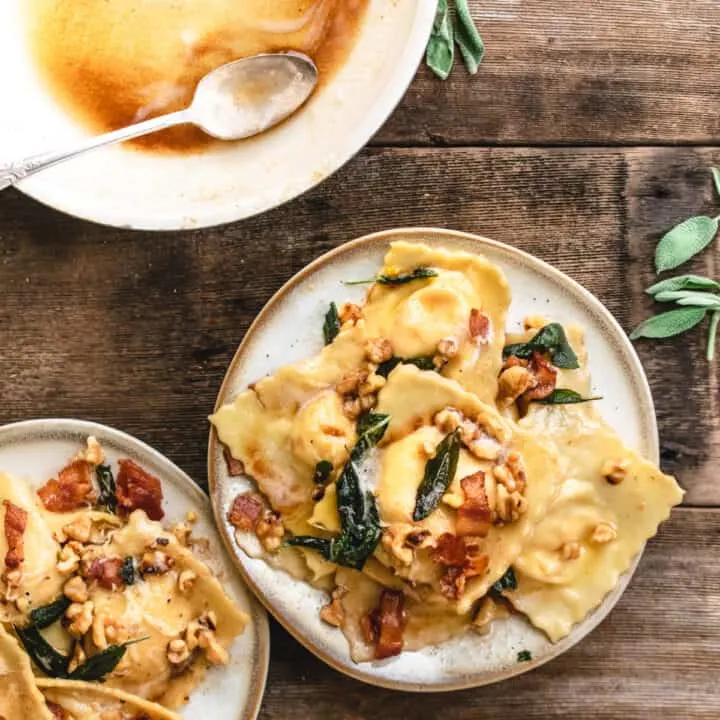
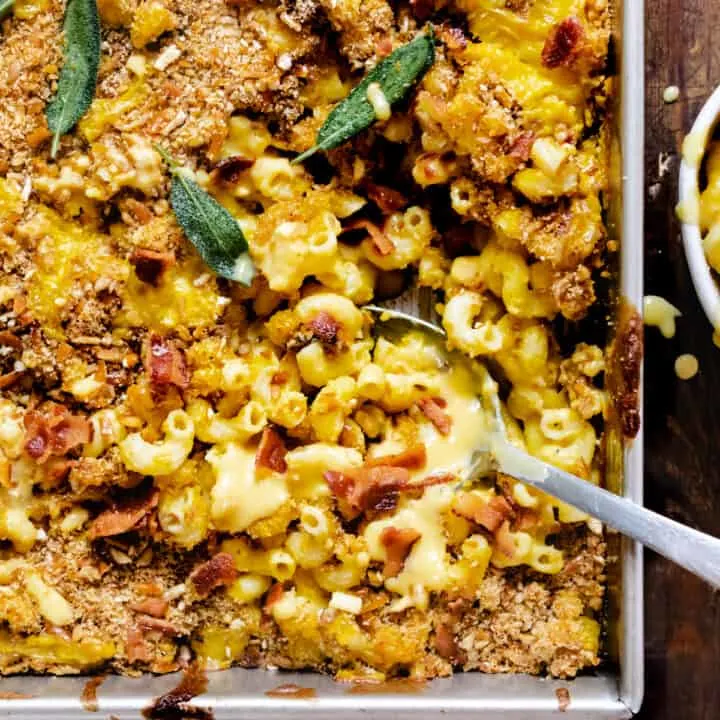
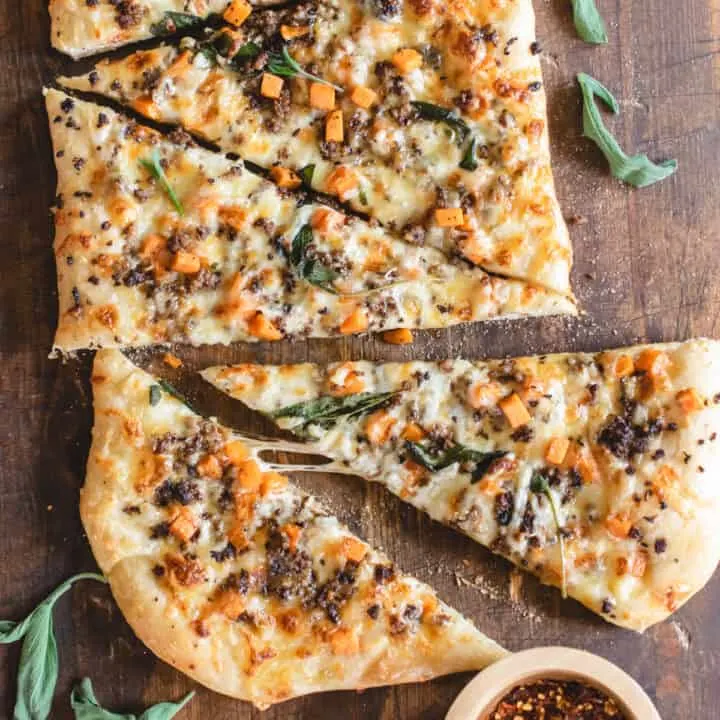
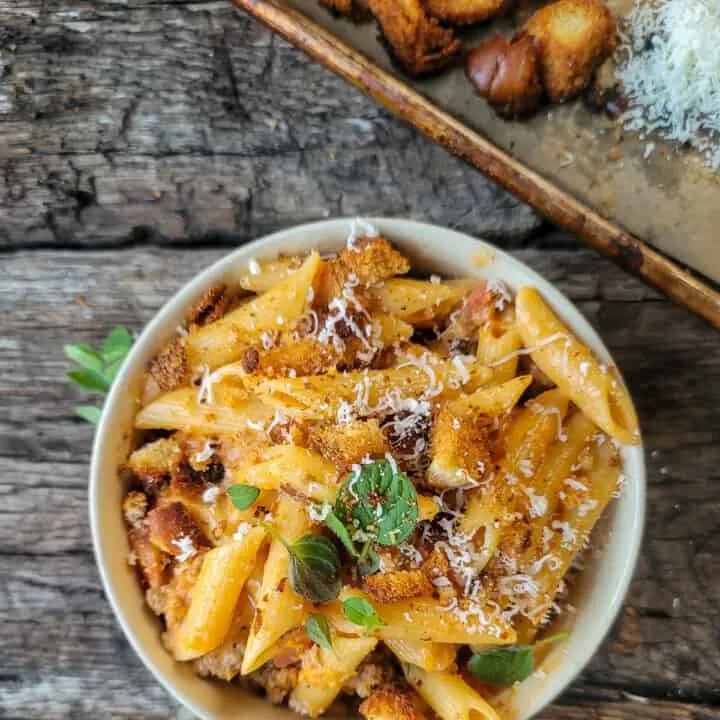
Debra Jo Hailey
Monday 22nd of January 2024
Owner of the Frozen Biscuit, Please check your comments. Someone who is craving negative attention is using your innocent platform as an opportunity to test out his/ her usage of foul language. Thanks!
Mary
Thursday 26th of October 2023
I stuffed mine with turkey Italian sausage, apples,spinach, and more and topped with fresh mozzarella. SO yummy!
Ken wills
Saturday 18th of November 2023
@Mary, fuck your mom in her tight ass hole
Nell
Saturday 1st of July 2023
Have a lot of them and would like a batch baked up to freeze. Can you do this?
Kathy Robertson
Sunday 4th of December 2022
Best i’ve ever had thank you
Margaret
Saturday 3rd of December 2022
Turned out perfect! So moist and tender!